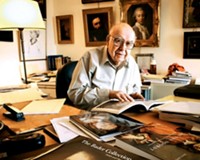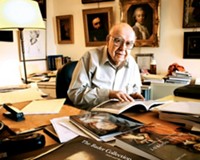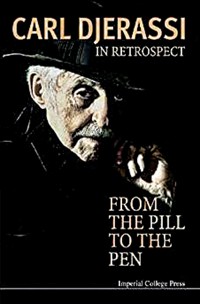Advertisement
Grab your lab coat. Let's get started
Welcome!
Welcome!
Create an account below to get 6 C&EN articles per month, receive newsletters and more - all free.
It seems this is your first time logging in online. Please enter the following information to continue.
As an ACS member you automatically get access to this site. All we need is few more details to create your reading experience.
Not you? Sign in with a different account.
Not you? Sign in with a different account.
ERROR 1
ERROR 1
ERROR 2
ERROR 2
ERROR 2
ERROR 2
ERROR 2
Password and Confirm password must match.
If you have an ACS member number, please enter it here so we can link this account to your membership. (optional)
ERROR 2
ACS values your privacy. By submitting your information, you are gaining access to C&EN and subscribing to our weekly newsletter. We use the information you provide to make your reading experience better, and we will never sell your data to third party members.
Environment
A Generous Chemist With A Keen Eye
Alfred Bader examines his later years in a new memoir
by Dudley Herschbach
March 16, 2009
| A version of this story appeared in
Volume 87, Issue 11
by Alfred Bader, Weidenfeld & Nicolson Ltd., 2008, 246 pages, $29.95 hardcover (ISBN 978–0-297–85512–5)

by Alfred Bader, Weidenfeld & Nicolson Ltd., 2008, 246 pages, $29.95 hardcover (ISBN 978–0-297–85512–5)
THIS SEQUEL to Alfred Bader’s first memoir, “Adventures of a Chemist Collector,” published in 1995, will delight everyone who has read that book and impel anyone who has not to do so. The new book, presenting further adventures, opens with a brisk synopsis of his first seven decades.
At age 14, Bader was among 10,000 children enabled by humanitarian efforts to escape to England in 1938, as the Nazis took over Vienna. Although he was a Jewish refugee in 1940 when Britain feared an imminent invasion, Bader was deported to Canada and interned with other “enemy aliens” in a prisoner-of-war camp. He was released after more than a year, and his diligent pursuit of education was rewarded by admission to Queen’s University, in Ontario, where he earned B.S. and M.S. degrees in engineering chemistry.
Bader then accepted a fellowship to Harvard University and undertook research with Louis Fieser. In his first year, he failed all eight cumulative exams. Undaunted, he passed the next six exams and completed his Ph.D. in well under three years.
In partnership with a friend, he launched Aldrich Chemical in 1951, which was incorporated with the minimum required capital of $500 and run from a garage. The impetus came from his experience as a graduate student, when he found that Eastman Kodak, then the only substantial supplier of organic research chemicals, was capricious and cavalier.
After one year, with no salaries paid, Aldrich posted a profit of just $20; but after three years, Bader dared to commit himself full-time and bought out his partner. By dint of rapid, reliable, and enterprising service to customers and astute judgment, over the next 20 years, he built Aldrich into a thriving business. In 1975, Aldrich merged with Sigma, a biochemical supplier. Bader was president and later chairman of the combined company, which grew to have annual sales of more than $1 billion. Yet in a bizarre coup, Bader was dismissed from the board of Sigma-Aldrich in 1992.
Much else in his first memoir exemplifies Bader’s steadfast devotion to worthy obsessions. Early on, he undertook philanthropic enterprises. These included creating the Alfred Bader Chemical Library to preserve rare research samples that might otherwise have been lost and providing grants to foster research in synthetic chemistry. He also avidly pursued collecting and dealing old master paintings. Most marvelous was his romance with his wife, Isabel. It involved a shipboard courtship, over 400 ardent letters, a separation of 25 years, and other elements apt for an opera or a fairy tale.
In “Chemistry & Art: Further Adventures of a Chemist Collector,” Bader describes many intriguing new exploits and revisits some earlier ones with the mellower perspective of his later years. The lead chapter is titled “Life After Expulsion.” To be ousted from the company he had strived mightily to build for 40 years was a staggering blow. But now, he feels, “I can truly say that I am much happier.”
As described in later chapters, the ousting liberated him to enjoy much more intense dealing in art, as well as his “most difficult” enterprise of “giving money away sensibly.” He also relishes making new investments, especially in fledgling chemical companies, and maintaining a vigorous speaking schedule, giving “many talks, fifty or sixty a year, from a menu of twelve.”
After Bader departed, Sigma-Aldrich’s performance declined markedly for several years. Not incidentally, Bader points out that the decline was reversed after a major reassessment that urged policies he had advocated. It resulted in a shake-up that jettisoned the very officer who had engineered Bader’s ouster. The company is now doing well, and its top management has reinstated Bader in a cherished role: “chemist collector” of paintings for covers of the journal Aldrichimica Acta, which he founded.
Fully half of the sequel (nine of 18 chapters) is devoted to Bader’s expanded pursuit of master paintings. His love for art reaches back to his boyhood in Vienna, where he especially admired Dutch paintings seen while “peering in the windows” of art dealers. It became an addiction when, as a graduate student at Harvard, he attended lectures on Rembrandt and his circle. By 1961, he had founded the gallery Alfred Bader Fine Arts as a part-time enterprise.
After his liberating expulsion from Sigma-Aldrich, he teamed up with international dealers in New York City, London, and Munich and became a leading collector and dealer, with access to “truly major works.” In his new book, Bader fondly recounts the provenance of several Rembrandts and other favorite paintings, which are depicted in more than 50 beautiful full-color plates.
HIS DESCRIPTION of the art world gamut is revealing and exuberant; chemists may sense a resemblance to multifaceted Bruegelese aspects of their molecular world. Bader tells of bidding battles at auctions, attribution puzzles solved or confounded, impulsive decisions, indecisive hesitations, astute acquisitions, satisfying sales, missed opportunities, and many generous gifts to museums, but also a few dismaying deaccessions, concealed damage to loaned paintings, and even two robberies (one never solved, the other partly so despite inept police work). Above all, however, Bader emphasizes the gratifying insight, help, and friendship offered by kindred spirits among “art historians, museum directors and curators around the world.”
Of particular interest for chemists is an elegant painting that graces the book jacket. It shows two young chemists watching intently while a blue precipitate forms in a yellow liquid as one of them pours in another yellow liquid. Bader bought the painting from an antique dealer in North Carolina and recognized the experiment depicted is the production of the dye prussian blue.

Eager to identify the pair of chemists and the artist, Bader published a paper about the painting that appealed for information. His offer of a reward was collected after a four-year quest. The painting’s date is 1816; the artist is Thomas Phillips; the chemist wielding the test tubes is William Brande, then 28 and Humphrey Davy’s successor as professor at the Royal Institution, in London; and the intense onlooker is Michael Faraday, then 24 and virtually unknown as a scientist. Later, the prussian blue synthesis became, for many years, a “star attraction” in lecture demonstrations by both chemists. Bader yearns to learn more about the trajectory of his painting, “the earliest portrait of that truly great and good scientist, Michael Faraday.”
Akin to his detective work on art, delving into the history of chemistry has been another of Bader’s abiding passions. He includes a chapter commemorating the efforts of William Wiswesser (1914–89), a chemical information expert, to acquaint chemists with remarkable proposals about molecular structure made by Josef Loschmidt (1821–95). A professor of physical chemistry at the University of Vienna, Loschmidt advanced in 1861 many prescient ideas about chemical structure.
In a little-known booklet, he displayed these in novel schematic diagrams. Among them are what appear to be cyclic structures for benzene and numerous other aromatic chemicals. That would preempt the benzene ring proposed in 1865 by Kekulé, who famously cited a dream as his inspiration.
Wiswesser, in failing health, submitted what became his last article to Aldrichimica Acta and passed on to Bader much material, urging him to continue the work on Loschmidt. In his commemorative chapter, Bader summarizes Wiswesser’s findings and his own, reported in several articles and many lectures, and calmly rebuts objections by some historians of chemistry. He concedes that he’d once suggested that Kekulé might have plagiarized Loschmidt but no longer thinks so. Rather, Bader concludes that the “first six-carbon monocyclic benzene structure was Loschmidt’s; the first cyclohexatriene, Kekulé’s...but the puzzle about its unsaturation was still to be addressed.” Today’s chemists may wonder how this controversy might have been viewed by Michael Faraday (1791–1867), who in 1825 first isolated and identified benzene, calling it “bicarburet of hydrogen.”
The book also abounds with engaging episodes and vignettes focused on a host of friends and family. Among these are charming accounts of multistage 80th birthday celebrations for both Alfred and Isabel. Especially striking are two chapters, each devoted to a particular friend. One, placed right after his postexpulsion reflections, describes a “treasured friendship” developed over nearly 50 years with Marvin Klitsner, “the greatest influence on my business life, and often my personal life.”
After Bader had settled in Milwaukee, they met through Klitsner’s daughters, who were in the Sunday school class that Bader taught at the Jewish Reform Temple (a commitment Bader continued for 32 years). As his attorney and mentor, Klitsner worked with Bader from the early days of Aldrich and became a partner in other ventures and many philanthropic projects. Among them is Alfred Bader Fine Arts, now half-owned by Bader’s two sons and half by Klitsner’s 19 grandchildren. Included in the chapter is a moving eulogy by Marvin’s son Steven, delivered in Jerusalem.
Bader describes many intriguing new exploits and revisits some earlier ones with the mellower perspective of his later years.
IN A LATER CHAPTER, Bader makes a painful, but admirable, confession. It is entirely concerned with an inconsiderate action of his that alienated an old friend. The friend, a German professor, was an esteemed art historian, particularly admired for his definitive works on paintings by Rembrandt students. Over 25 years, Bader had frequently visited him and exchanged letters discussing paintings; the professor was wonderfully helpful and they were on a familiar “Du basis.”
At an auction in 2003, Bader disagreed with a dealer he thought accepted too uncritically an assessment by the Rembrandt Research Project (RRP). Hoping to make the dealer reconsider, Bader sent him a copy of a 1981 letter from his professor friend that had been “harshly critical” of RRP. His friend was appalled that Bader, without asking permission or even informing him, had passed on to a stranger a private letter written 22 years earlier expressing views he no longer held. That ended the friendship; contrite letters from Bader were returned unopened.
Several chapters describe philanthropic initiatives, new or enhanced. In many benefactions, Alfred and Isabel Bader have sought out opportunities to “help the neediest and ablest.” Expressing gratitude for support they had received as students, they have funded numerous scholarships at universities in Canada, the U.S., and abroad.
Typical of their creative approach is generous support of the American Chemical Society’s Project SEED. It enables high school students from families lacking means to conduct mentored research in academic, industry, or government laboratories during the summer. The Baders felt that a second summer would be a great advantage, so they augmented the program. They also made a 30-year commitment to provide funds, matched by ACS, for 20 college scholarships to support SEED alumni who go on to universities (now above 90%, with 7% attaining Ph.D.s).
BADER BENEFACTIONS often have the aim of “not only paying lip service to concepts of equality and diversity but actually implementing it on the ground.” They support several strategic approaches to foster Jewish-Arab relations within Israel. Among these are many ongoing projects based in public libraries, equally in Jewish and Arab communities. Done in partnership with the Israeli Ministry of Education, this work leverages matching government grants that did not previously exist for the Arab sector. It led also to establishing libraries in Bedouin villages and other places where public libraries had never been. Other characteristic grants have helped children of Roma gypsies in Kosovo and Prague in dire need of medical care.
Some grand gifts honor their alma maters: Queen’s University for Alfred and Victoria University, in Toronto, for Isabel. To Queen’s University, over several decades, Alfred has given professorships and other benefactions in many fields and more than 100 paintings, including two Rembrandts. Most bold was the gift and renovation of the 15th-century, 140-room Herstmonceux Castle, in Sussex, England, to serve as Queen’s International Study Centre. To Victoria University, the Baders gave a performing arts theater, opened in 2001 and named for Isabel. Recently, the Baders purchased waterfront land on Lake Ontario to be the future site of Queen’s performing arts campus; this property will also have a theater named for Isabel.
This sequel memoir, like its predecessor, relates extraordinary doings with verve and earnest frankness. There is also much gratitude, joy, and faith in the telling. From that emerge transcendent insights into human chemistry and art.
Dudley R. Herschbach, a Nobel Laureate in Chemistry, is Baird Professor of Science at Harvard University, emeritus. He has long strived to teach chemistry as a liberal art.





Join the conversation
Contact the reporter
Submit a Letter to the Editor for publication
Engage with us on Twitter